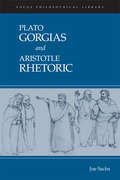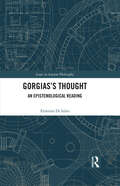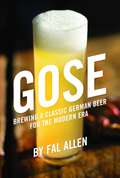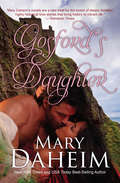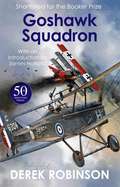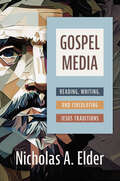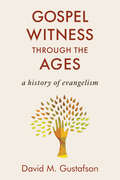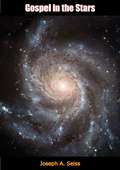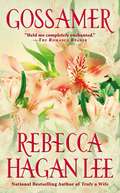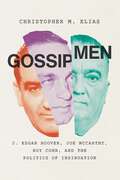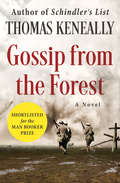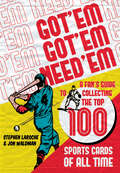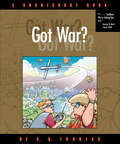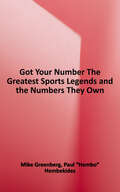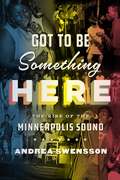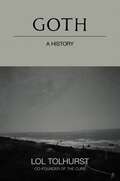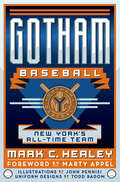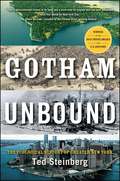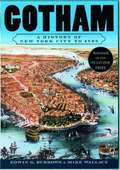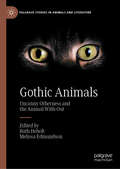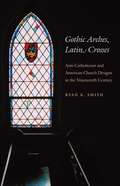- Table View
- List View
Gorgias and Rhetoric
by Plato Aristotle Joe SachsBy pairing translations of Gorgias and Rhetoric, along with an outstanding introductory essay, Joe Sachs demonstrates Aristotles response to Plato. If in the Gorgias Plato probes the question of what is problematic in rhetoric, in Rhetoric, Aristotle continues the thread by looking at what makes rhetoric useful. By juxtaposing the two texts, an interesting "conversation" is illuminated--one which students of philosophy and rhetoric will find key in their analytical pursuits.Focus Philosophical Library translations are close to and are non-interpretative of the original text, with the notes and a glossary intending to provide the reader with some sense of the terms and the concepts as they were understood by Aristotle and Plato's immediate audience.
Gorgias's Thought: An Epistemological Reading (Issues in Ancient Philosophy)
by Erminia Di IulioGorgias’s Thought: An Epistemological Reading is the first monograph published in English entirely devoted to Gorgias’s epistemological thought and provides a new perspective on Gorgias’s thought more broadly. The book aims to undermine the common idea that Gorgias is either an orator uncommitted to any conception of truth, or a thinker whose interest is confined to the philosophy of language. It considers his major texts—On What is Not, or On Nature, The Apology of Palamedes and The Encomium of Helen—emphasising the originality and specificity of Gorgias’ thought. In combining a philological analysis with substantive use of contemporary epistemological approaches, Di Iulio shows that Gorgias is to be considered first and foremost an epistemologist. Gorgias’s Thought: An Epistemological Reading is of interest to students, scholars and specialists in ancient thought, epistemology, history of philosophy and rhetoric.
Gose: Brewing a Classic German Beer for the Modern Era
by Fal AllenExplore the sensation of tart, fruity and refreshing Gose-style beers, popular in Germany centuries ago and experiencing a renaissance today. Follow the development of this lightly sour wheat beer as it grew, then bordered on extinction, before surging into popularity due to the enthusiasm and experimentation of American craft brewers. Gose explores the history of this lightly sour wheat beer style, its traditional ingredients and special brewing techniques. Discover brewing methods from the Middle Ages and learn how to translate them to modern day beer. Learn about salinity, spices, and lactic acid as you experiment with Gose recipes from some of the best-known craft brewers of our time. This refreshing journey captures the innovation and experimentation that is occurring within the style and help you brew your own Gose-style beers.
Gosford's Daughter
by Mary DaheimFrom a beloved mystery author, this much-anticipated return to historical romance in the Scottish Highlands “brings history to vibrant life” (Romantic Times). Scottish Highlands, 1585. Seventeen-year-old Sorcha Fraser is impatient to venture outside of her close-knit family circle at Gosford’s End. And she doesn’t have long to wait. While out riding, Sorcha meets a compelling young man in priestly robes, but can’t foresee that Gavin Napier’s destiny is deeply linked with her own. Fate will time and again bring them together—in danger and in love . . . As Catholics in Protestant Scotland, Sorcha and Gavin are endagered. Even King James has renounced the religion of his mother, Mary Stuart, Queen of Scots, and those who remain loyal to their “popish” ways are in grave danger. Yet at court, Sorcha becomes a favorite of King James, who sends her to comfort his imprisoned mother in England. After Mary’s execution, Sorcha returns to Scotland to find the capricious monarch entangled with vicious advisors and courtesans, whose dark motives could destroy the country and the love of Gavin Napier and Sorcha. “Daheim’s prose is engaging, and her novel has all the best ingredients of a well-researched historical romance” (Historical Novel Society).
Goshawk Squadron
by Derek RobinsonWorld War One pilots were the knights of the sky, and the press and public idolised them as gallant young heroes. At just twenty-three, Major Stanley Woolley is the old man and commanding officer of Goshawk Squadron. He abhors any notion of chivalry in the clouds and is determined to obliterate the decent, gentlemanly outlook of his young, public school-educated pilots - for their own good. But as the war goes on he is forced to throw greener and greener pilots into the meat grinder. Goshawk Squadron finds its gallows humour and black camaraderie no defence against a Spandau bullet to the back of the head.
Goshawk Squadron
by Derek RobinsonWorld War One pilots were the knights of the sky, and the press and public idolised them as gallant young heroes. At just twenty-three, Major Stanley Woolley is the old man and commanding officer of Goshawk Squadron. He abhors any notion of chivalry in the clouds and is determined to obliterate the decent, gentlemanly outlook of his young, public school-educated pilots - for their own good. But as the war goes on he is forced to throw greener and greener pilots into the meat grinder. Goshawk Squadron finds its gallows humour and black camaraderie no defence against a Spandau bullet to the back of the head.
Gospel Media: Reading, Writing, and Circulating Jesus Traditions
by Nicholas A. ElderContextualizing the gospels in ancient Greco-Roman media practices New Testament scholars have often relied on outdated assumptions for understanding the composition and spread of the gospels. Yet this scholarship has spread myths or misconceptions about how the ancients read, wrote, and published texts. Nicholas Elder updates our knowledge of the gospels&’ media contexts in this myth-busting academic study. Carefully combing through Greco-Roman primary sources, he exposes what we take for granted about ancient reading cultures and offers new and better ways to understand the gospels. These myths include claims that ancients never read silently and that the canonical gospels were all the same type of text. Elder then sheds light on how early Christian communities used the gospels in diverse ways. Scholars of the gospels and classics alike will find Gospel Media an essential companion in understanding ancient media cultures.
Gospel Witness through the Ages: A History of Evangelism
by David M. GustafsonA definitive history of Christian evangelism—including noteworthy persons, movements, and methods from the past Christians have been sharing the good news of Jesus Christ with nonbelievers for two thousand years. Within this deep history is wisdom for today—including numerous models for understanding what evangelism is and how it should be done. In Gospel Witness through the Ages, David Gustafson introduces readers to evangelism&’s noteworthy persons, movements, and methods from the entire scope of church history—including both examples to emulate and examples to avoid. With this thorough historical approach, Gustafson expands the reader&’s conception of the evangelistic task and suggests new ways to shape our identity as gospel witnesses today through the influence of these earlier generations of Christians. With discussion questions for further reflection and primary sources from major evangelistic figures of the past, Gospel Witness through the Ages is the most definitive history of evangelism available—essential for understanding how Christians today can continue proclaiming the gospel to the whole world, as Christians have in every century past.
Gospel in the Stars: Biblical Astronomy; The Heavens Above, Their Importance In The New Testament Gospels Of Jesus Christ
by Joseph A. SeissWritten in 1882 by one of the most popular Lutheran preachers of the day, this book draws on scientific, historical, and biblical sources. It shows that not astrology, but rather the gospel of Jesus can be seen in the stars. Seiss believed that the heavens revealed God's glory and his plan of salvation. Seiss was convinced that God had etched His good news in the heavens, that people in darkness might see and gain hope.—Print ed.
Gospel of Disunion
by Mitchell SnayThe centrality of religion in the life of the Old South, the strongly religious nature of the sectional controversy over slavery, and the close affinity between religion and antebellum American nationalism all point toward the need to explore the role of religion in the development of southern sectionalism. In Gospel of Disunion Mitchell Snay examines the various ways in which religion adapted to and influenced the development of a distinctive southern culture and politics before the Civil War, adding depth and form to the movement that culminated in secession. From the abolitionist crisis of 1835 through the formation of the Confederacy in 1861, Snay shows how religion worked as an active agent in translating the sectional conflict into a struggle of the highest moral significance. At the same time, the slavery controversy sectionalized southern religion, creating separate institutions and driving theology further toward orthodoxy. By establishing a biblical sanction for slavery, developing a slaveholding ethic for Christian masters, and demonstrating the viability of separation from the North through the denominational schisms of the 1830s and 1840s, religion reinforced central elements in southern political culture and contributed to a moral consensus that made secession possible.
Gossamer
by Rebecca Hagan LeeFrom the national bestselling author of Truly a Wife comes a wonderful and tender romance set in nineteenth-century San Francisco. When wealthy businessman James Craig was awakened by heartrending weeping in the night, he thought he was reliving his painful past. But what he found was not his worst nightmare, but a beautiful and fragile dream, who made him yearn for a future...with her... Frightened and in desperate straits, Elizabeth Sadler arrived in San Francisco full of hope for a new life. But her hope was destroyed when she found herself alone and penniless. Then, like an angel in the night, an enegmatic stranger heard her cries, gave her comfort--and offered her a job as governess to his four daughters. In his eyes, she saw a love that promised her heaven. But angry whispers surround him--and keep him and his family separate from a town too prejudiced and suspicious to accept them. The ugly rumors, and the shadows of a past tragedy threaten to create an impenetrable barrier between James and Elizabeth. To love him, she must find the courage to stand by him, in the face of an ignorant and fearful society, and her own secret doubts... Includes a preview of the sequel, A Wanted Man.
Gossip Men: J. Edgar Hoover, Joe McCarthy, Roy Cohn, and the Politics of Insinuation
by Christopher M. EliazJ. Edgar Hoover, Joseph McCarthy, and Roy Cohn were titanic figures in midcentury America, wielding national power in government and the legal system through intimidation and insinuation. Hoover’s FBI thrived on secrecy, threats, and illegal surveillance, while McCarthy and Cohn will forever be associated with the infamous anticommunist smear campaign of the early 1950s, which culminated in McCarthy’s public disgrace during televised Senate hearings. In Gossip Men, Christopher M. Elias takes a probing look at these tarnished figures to reveal a host of startling new connections among gender, sexuality, and national security in twentieth-century American politics. Elias illustrates how these three men solidified their power through the skillful use of deliberately misleading techniques like implication, hyperbole, and photographic manipulation. Just as provocatively, he shows that the American people of the 1950s were particularly primed to accept these coded threats because they were already familiar with such tactics from widely popular gossip magazines. By using gossip as a lens to examine profound issues of state security and institutional power, Elias thoroughly transforms our understanding of the development of modern American political culture.
Gossip from the Forest: A Novel
by Thomas KeneallyA gripping reimagining of the drama, ego, intrigue, and madness at work during the World War I armistice negotiations In November 1918, after four long years of murderous conflict, six men gather in a railroad car in a secluded forest outside Paris, France, to negotiate an end to World War I. A pacifist, left-leaning diplomat with no military knowledge or experience, Matthias Erzberger has been selected by the German high command to represent their surrendering nation, for reasons as baffling to him as to anyone. He is joined by France's aging, vindictive Marshal Foch and Britain's unbending Admiral Wemyss in an attempt to bring peace to a war-torn world. In these claustrophobic quarters the future is to be decided by men driven by ego, prejudice, fear, exhaustion, vengeance, delusion, and, in Erzberger's case, conscience. But the well-meaning diplomat's futile efforts to secure lenient surrender terms will have devastating consequences for Europe, the Fatherland, and Erzberger himself. Renowned for his enthralling fictional accounts of historical events, award-winning author of Schindler's List Thomas Keneally once again brings the heart-stopping human drama of history to life, as he brilliantly envisions the earth-shattering events that transpired in the forest of Compiègne, setting the stage for the Treaty of Versailles and the rise of the Third Reich.
Got 'Em, Got 'Em, Need 'Em: A Fan's Guide to Collecting the Top 100 Sports Cards of All Time
by Jon Waldman Stephen LarocheFor over a hundred years, kids of all ages have enjoyed the thrill of collecting sports cards. Whether it was souvenirs from their parents&’ cigarette packs, pieces that came in bubble gum packages, or the modern dazzlers, the simple formula of pictures and text on cardboard have been a part of North American society for over a century.Now, take a look back at one of the most popular hobbies in history with Got &’Em, Got &’Em, Need &’Em. Covering baseball, basketball, football, hockey, boxing, and golf, this unique book offers a look at the greatest sports cards ever produced, including the players and personalities involved. Relive the days gone by with some of the industry&’s most well-known experts as we count down the best from the business.Plus, as a special bonus, take a look at the best innovations, the worst blunders, and a special tribute to the hobby&’s boom era in the 1990s.
Got 'Em, Got 'Em, Need 'Em: A Fan's Guide to Collecting the Top 100 Sports Cards of All Time
by Jon Waldman Stephen LarocheFor over a hundred years, kids of all ages have enjoyed the thrill of collecting sports cards. Whether it was souvenirs from their parents&’ cigarette packs, pieces that came in bubble gum packages, or the modern dazzlers, the simple formula of pictures and text on cardboard have been a part of North American society for over a century.Now, take a look back at one of the most popular hobbies in history with Got &’Em, Got &’Em, Need &’Em. Covering baseball, basketball, football, hockey, boxing, and golf, this unique book offers a look at the greatest sports cards ever produced, including the players and personalities involved. Relive the days gone by with some of the industry&’s most well-known experts as we count down the best from the business.Plus, as a special bonus, take a look at the best innovations, the worst blunders, and a special tribute to the hobby&’s boom era in the 1990s.
Got War?: A Doonesbury Book (Doonesbury #23)
by G. B. Trudeau"Rear Admiral Steve Kunkle, commander of the carrier strike force, grimaced at a Doonesbury comic strip from the Japan Times. It showed a Navy pilot thinking 'Oops!'" As Doonesbury shifts to a wartime footing, the strip's major players find themselves pre-positioned for the coming cakewalk. Weekend warrior B.D. leaves the Fighting Swooshes of Walden in the care of acting Coach Boopstein, returning to the sands of Kuwait as Camp Blowback's Public Affairs Officer. Among his charges: Roland Hedley, veteran of a grueling combat training program designed to keep media folk from getting capped. Offshore, the irrepressible Morale Officer Lieutenant. Tripler goes live ("Good MORNING, regime-changers!") to lift the shipbound spirits of his pre-swarthy charges, while offstage, Viceroy-in-Waiting Duke prepares to answer empire's call. Stateside, Mike takes up a flanking position on the sofa to log some serious CNN time, while the Reverend Sloan girds his loins for peace: "Look for us on TV-we'll be a million strong." Marching to the beat of a different cause, Zonker's old surfing mentor tries to enlist Z in a desperate fight to liberate Left Coastal access. Protests Zonk, "What can I do? I am but one dude!" Meanwhile, Jeff Redfern is but one CIA intern, yet he manages to launch a Predator drone and, using basic Nintendo training, knock out an Al-Q ammo dump. Also taking a hit, Trent Lott, busted for giving props to segregation. "I was trying to say I was down with the hood!" he backpedals, realizing too late that Mr. James Crow has finally left the house.With Alex declaring eco-jihad on SUVs, and Elmont launching a daily assault on coherence as on-line blogger "Jenny McTagart, Girl Pirate," it's hard to see a peaceful world ahead. But Jimmy Thudpucker can. Waging war on the recording industry, he and other filesharers have a vision of ultimate change de regime: "The suits die off, and Pepperland will be free again."
Got Your Number: The Greatest Sports Legends and the Numbers They Own
by Mike GreenbergESPN personality (Get Up and #Greeny) and New York Times bestselling author Mike Greenberg partners with mega-producer Hembo to settle once and for all which legends flat-out own which numbers. In short essays certain to provoke debate between and amongst all generations, Greeny uses his lifetime of sports knowledge to spin yarns of the legends among the legends and tell you why some have claimed their spot in the top 100 of all time. <p><p>Sports and numbers go hand in hand. Sports and loud, assertive debate? Even better. Cheering on, agonizing over, and being in plain awe of your favorite players has left you with a deep and intricate memory of their greatness, not to mention well-honed arguments as to why your favorites are really the best. In arenas, in front of your TV, and in bars, you’ve debated friends and strangers alike. You’ve joyfully mocked your friends’ (sometimes laughable) favorites. You’ve spouted accomplishments, statistics: Yours won six titles, batted .350 in the clutch, or generated 82% of their team’s scoring. <p><p>But not all numbers are created equal. Some are accomplishments. Others are identity. Looming large over any image you have of an athlete: the number on their jersey. Numbers often provide the most visceral parts of any sports legend’s identity. They are what people remember—worldwide. Jordan, Jeter, Brady—to fans, they are as much their number as they are anything else. Sure, 1 through 100 might seem like a large range, but fierce competition across the ages has blessed only a lucky few to claim one of these as their own. For some, the victors may not be so obvious. That’s why Greeny’s here to help. <p><p>Ascend into discussion, fans of all stripes. Come away enlightened. Or maybe a little enraged. Either way, you are sure to be occasionally surprised—and endlessly entertained. Whatever your sport, welcome to the place where all the arguments are finally decided, once and for all.
Got to Be Something Here: The Rise of the Minneapolis Sound
by Andrea SwenssonBeginning in the year of Prince&’s birth, 1958, with the recording of Minnesota&’s first R&B record by a North Minneapolis band called the Big Ms, Got to Be Something Here traces the rise of that distinctive sound through two generations of political upheaval, rebellion, and artistic passion.Funk and soul become a lens for exploring three decades of Minneapolis and St. Paul history as longtime music journalist Andrea Swensson takes us through the neighborhoods and venues, and the lives and times, that produced the Minneapolis Sound. Visit the Near North neighborhood where soul artist Wee Willie Walker, recording engineer David Hersk, and the Big Ms first put the Minneapolis Sound on record. Across the Mississippi River in the historic Rondo district of St. Paul, the gospel-meets-R&B groups the Exciters and the Amazers take hold of a community that will soon be all but erased by the construction of I-94. From King Solomon&’s Mines to the Flame, from The Way in Near North to the First Avenue stage (then known as Sam&’s) where Prince would make a triumphant hometown return in 1981, Swensson traces the journeys of black artists who were hard-pressed to find venues and outlets for their music, struggling to cross the color line as they honed their sound. And through it all, there&’s the music: blistering, sweltering, relentless funk, soul, and R&B from artists like Maurice McKinnies, Haze, Prophets of Peace, and The Family, who refused to be categorized and whose boundary-shattering approach set the stage for a young Prince Rogers Nelson and his peers Morris Day, André Cymone, Jimmy Jam, and Terry Lewis to launch their careers, and the Minneapolis Sound, into the stratosphere. A visit to Prince&’s Paisley Park and a conversation with the artist provide a rare glimpse into his world and an intimate sense of his relationship to his legacy and the music he and his friends crafted in their youth.
Goth: A History
by Lol TolhurstThe co-founder of The Cure and author of Cured delivers a fascinating deep dive into the dark romanticism of Goth music, a misunderstood genre and culture. GOTH is an entertaining and engaging historical memoir, and a journey through Goth music and culture, exploring creative giants like The Cure, Siouxsie and the Banshees, Bauhaus, Joy Division, and many more great bands that offered a place of refuge for the misfits of the &‘80s and ever since. Written by Lol Tolhurst, co-founder of The Cure, this book offers a riveting retrospective of the genre&’s iconic movers and shakers, infused with stories from Tolhurst&’s personal trove of memories, as well as anecdotes about the musicians, magicians, and artists who made it all happen—the people, places, and things that made Goth an inevitable and enduring movement. Starting with the Origins of Goth, Tolhurst explores early art and literature that inspired the genre and looks into the work of T.S Eliot, Edgar Allan Poe, Sylvia Plath, and Albert Camus, among others. He also outlines the path of Gothic Forebears and shows how many musicians played in punk bands before transitioning into Goth endeavors. Next, he introduces readers to the &“Architects of Darkness&”—Bauhaus, Siouxsie and the Banshees, Joy Division, and The Cure—the Godfathers of Goth who established the genre's roots. Following these early bands, Tolhurst discusses a group he calls the &“Spiritual Alchemists,&” consisting of bands like Depeche Mode, Cocteau Twins, and more, who helped the darkness expand into the culture. He also tracks the expansion of the genre overseas, from England to New York, Los Angeles, and beyond. Gothic fashion was an important part of the movement as well, and Tolhurst discusses the clothing that accompanied and complemented the music. Finally, Tolhurst examines the legacy of Goth music, and shows how its influence can still be seen to this day across music, film, TV, visual arts, social media, and more. As thoughtful and thorough as it is utterly bewitching, GOTH is a timeless testament to why Goth matters—and why it always will.
Gotham Baseball: New York's All-Time Team (Sports Ser.)
by Mark C Healey&“The Big Apple&’s greatest squad . . . Selecting either a Brooklyn Dodgers, New York Giants, New York Yankees or New York Mets player for each position.&” —Long Island Herald Baseball may be the great American pastime, but in New York, it is a religion. Names like Ruth, Mays, Gehrig, Wright and Robinson live in the hearts and minds of New York fans like apostles. From the street corner to the subway car, debates about which Yankee, Giant, Dodger or Met is better than another have raged on for more than one hundred years. Now, the best of the best are chosen for each position as New York&’s all-time greatest team is imagined. Shoo-ins like the Babe and Jackie have their stories told with a fresh perspective. The compelling case for Mike Piazza, not Yogi Berra, as catcher is sure to spark arguments. Sportswriter Mark Healey crafts the Gotham baseball team through captivating tales of the legends of the New York game. &“One of the best Baseball Teams books of all time.&” —BookAuthority &“Many a sportswriter in a column and many a baseball fan in a New York City sports bar have tried to say that their guys were the best; but what if you could put the greatest in Gotham&’s rich baseball history—the very, very best—on one team? . . . Mark C. Healey endeavors to do just that—and start a few more arguments along the way.&” —Queens Chronicle
Gotham Unbound
by Ted SteinbergThis is the story of the monumental struggle between New York and the natural world. From Henry Hudson's discovery of Mannahatta to Hurricane Sandy, Gotham Unbound is Ted Steinberg's sweeping ecological history of one of the most man-made spots on earth.Here is a tale of "the world with us"--lots of us--a groundbreaking book that recounts the four-century history of how hundreds of square miles of open marshlands became home to six percent of the nation's population. Steinberg vividly brings a vanished New York back to life. You will see the metropolitan area anew, not just as a dense urban goliath but as an estuary once home to miles of oyster reefs, wolves, whales, and blueberry bog thickets. That world gave way to an onslaught managed by thousands, from Governor John Montgomerie, who turned water into land, and John Randel, who imposed a grid on Manhattan, to Robert Moses, Charles Urstadt, Donald Trump, and Michael Bloomberg. This book is a powerful account of the relentless development that New Yorkers wrought as they plunged headfirst into the floodplain and transformed untold amounts of salt marsh and shellfish beds into a land jam-packed with people, asphalt and steel, and the reeds and gulls that thrive among them. With metropolitan areas across the globe on a collision course with rising seas, Gotham Unbound is a penetrating history that helps explain how one of the most important cities in the world wound up in such a perilous situation.
Gotham: A History of New York City to 1898
by Mike Wallace Edwin G. BurrowsWinner of the 1999 Pulitzer Prize for History.
Gothia: Muerte en Barcinona
by Santiago CastellanosUna novela que nos cuenta un momento crucial de la historia de la Península. Barcinona, actual Barcelona, año 415. Clodia, una dama de la aristocracia, vive con gran intensidad tanto su amor a la Historia y a los libros como su odio a la sociedad patriarcal romana y al triunfo del cristianismo. Lucha por sus libertades, se recluye en su biblioteca, vive romances y disfruta del sexo más allá de su odioso esposo Minicio. Todo eso le permite respirar en la asfixiante mediocridad de un entorno lleno de hipocresía y recelos. Es en ese ambiente de fiestas y falsas apariencias donde irrumpen los godos, que se asientan por primera vez en Hispania, alterando el orden marcado por Roma. Mientras los poderosos locales intentan sobrevivir al cambio de época y los líderes godos hacen frente a sus rivalidades, una serie de muertes dentro de los muros de Barcinona, entre ellas la del rey Ataúlfo, inquieta cada vez más a sus habitantes. Corren tiempos convulsos y cualquiera puede ser el asesino. El choque entre romanos y godos, el ansia de libertad de Clodia, el ascenso del cristianismo y las intrigas de poder introducen al lector en este fascinante thriller histórico que es, al mismo tiempo, un gran fresco literario sobre la ambición y las traiciones.
Gothic Animals: Uncanny Otherness and the Animal With-Out (Palgrave Studies in Animals and Literature)
by Melissa Edmundson Ruth HeholtThis book begins with the assumption that the presence of non-human creatures causes an always-already uncanny rift in human assumptions about reality. Exploring the dark side of animal nature and the ‘otherness’ of animals as viewed by humans, and employing cutting-edge theory on non-human animals, eco-criticism, literary and cultural theory, this book takes the Gothic genre into new territory. After the dissemination of Darwin’s theories of evolution, nineteenth-century fiction quickly picked up on the idea of the ‘animal within’. Here, the fear explored was of an unruly, defiant, degenerate and entirely amoral animality lying (mostly) dormant within all of us. However, non-humans and humans have other sorts of encounters, too, and even before Darwin, humans have often had an uneasy relationship with animals, which, as Donna Haraway puts it, have a way of ‘looking back’ at us. In this book, the focus is not on the ‘animal within’ but rather on the animal ‘with-out’: other and entirely incomprehensible.
Gothic Arches, Latin Crosses
by Ryan K. SmithCrosses, candles, choir vestments, sanctuary flowers, and stained glass are common church features found in nearly all mainline denominations of American Christianity today. Most Protestant churchgoers would be surprised to learn, however, that at one time these elements were viewed with suspicion as foreign implements associated strictly with the Roman Catholic Church. Blending history with the study of material culture, Ryan K. Smith sheds light on the ironic convergence of anti-Catholicism and the Gothic Revival movement in nineteenth-century America.Smith finds the source for both movements in the sudden rise of Roman Catholicism after 1820, when it began to grow from a tiny minority into the country's largest single religious body. Its growth triggered a corresponding rise in anti-Catholic activities, as activists representing every major Protestant denomination attacked "popery" through the pulpit, the press, and politics. At the same time, Catholic worship increasingly attracted young, genteel observers around the country. Its art and its tangible access to the sacred meshed well with the era's romanticism and market-based materialism.Smith argues that these tensions led Protestant churches to break with tradition and adopt recognizably Latin art. He shows how architectural and artistic features became tools through which Protestants adapted to America's new commercialization while simultaneously defusing the potent Catholic "threat." The results presented a colorful new religious landscape, but they also illustrated the durability of traditional religious boundaries.
